- Joined
- Sep 11, 2015
- Messages
- 293
Is it common practice to do such a thing? I just recently installed a DRO on my Grizzly G4003G, and I didn't have a 110v plug near the lathe. So with the help of my father, he explained how the electrical system in my lathe worked and how the 220v coming in gets split and what not.
It was fairly simple to wire the DRO monitor to a clean, protected circuit inside the electrical box. Now I don't have any cords plugging into any unnecessary outlets. If anybody would like to see the wiring, I'll gladly share it.
It was fairly simple to wire the DRO monitor to a clean, protected circuit inside the electrical box. Now I don't have any cords plugging into any unnecessary outlets. If anybody would like to see the wiring, I'll gladly share it.


